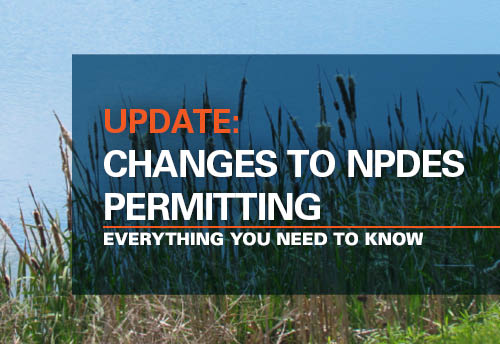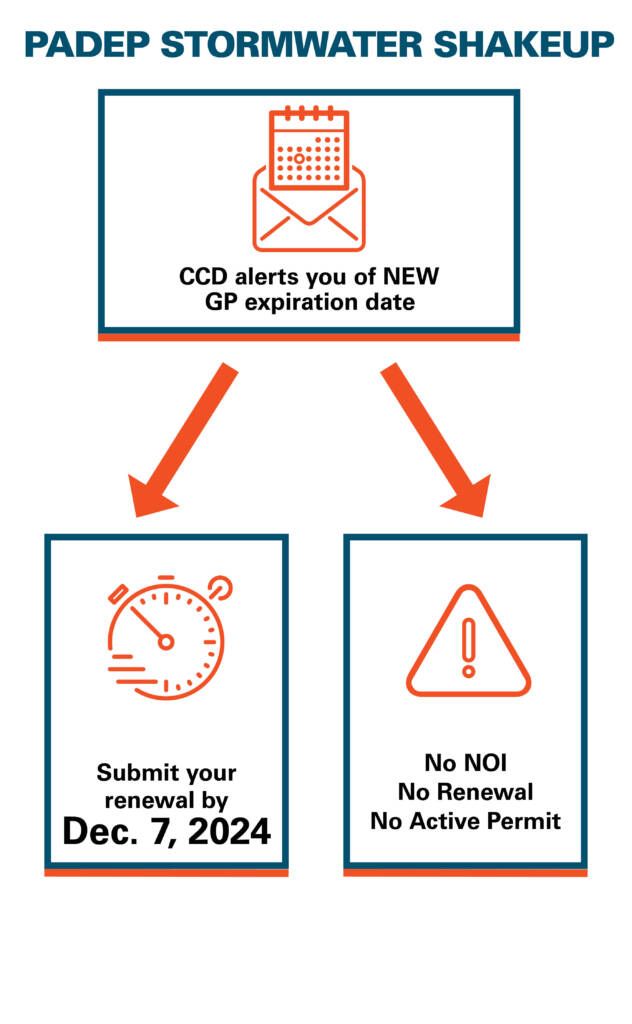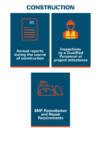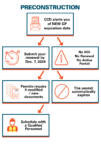
On August 30, 2024, the Pennsylvania Department of Environmental Protection (PADEP) announced the new PAG-02 General National Pollutant Discharge Elimination System (NPDES) Construction Stormwater Permit requirements.
There are numerous moving parts to this update but the good news for you is that we are educating ourselves as more information becomes public. Don’t worry, you do not need to memorize all the acronyms or forms to complete, we are here to help you through it all efficiently and cost effectively.
So, let’s break it down:
What does this mean for you and your existing project?
Check your mail. If you have an active permit, you should have received a letter from the County Conservation District (CCD) in which your property resides with a warning of the upcoming expiration of your permit. The simple fact: If you currently have a NPDES PAG-02 General Permit (GP) open, you need to renew your permit or it will expire automatically.
To notify your CCD of your renewal, you must submit a Renewal Notice of Intent (NOI) to the CCD by December 7, 2024. Don’t procrastinate this task,  we recommend completing the Renewal NOI as soon as possible.
we recommend completing the Renewal NOI as soon as possible.
Once a permit expires, it cannot be renewed. Renewing is key to avoiding a new, full NOI submission and will save you time and money.
(Confused? Give us a shout and we are happy to help you with unpacking your CCD letter and / or composing a Renewal NOI.)
Important dates you should know:
- August 31, 2024 – CCDs begin accepting permit renewals (extends permit coverage to 12/7/2029).
- December 7, 2024 – All permits expire.
- December 8, 2024 – All new regulations go into effect and new permits / modifications must utilize new application forms.
- December 8, 2025 – All visual site inspections for a new PAG-02 permit must be conducted by qualified personnel (we will cover what this means in the next blog post).
- TBD (2025-2026?) – New Post Construction Stormwater Management (PCSM) Manual released to replace Best Management Practice (BMP) manual.
What if you’re starting a new project next year?
First, our team can help you determine the type of NPDES permit coverage you need for stormwater discharges associated with construction activities in Pennsylvania. If the property is under 5 acres, the PAG-01 General NPDES Permit still applies as normal. There is more paperwork associated with permits should the property discharge to certain protected watersheds/or existing drainage basins.
Sweating these details does not have to be your top priority – Contact K&W to evaluate your project location to make sure you are completing the right form. We’re happy to start navigating you through the permitting process to avoid backwards work.
Let’s say we help you submit your Renewal NOI – is it over? Not just yet, let’s talk about what else you can expect.
What’s different?
There are 5 new parts of proper construction stormwater permitting that change starting Dec 8, 2024 (don’t worry about memorizing them all, that’s what we’re here for):
New forms:
- PAG-02 Application / Modules (existing documents, but modified)
- Erosion Potential Analysis (new form – replaces offsite discharge analysis)
- Annual Report (new)
- PADEP will start accepting the report on Sept 30 of each year.
- Must be filed by December 7 of each year following one full year of permit coverage.
- SCM Construction Certification Form (new)
- This certification must be submitted to PADEP within 30 days of the completion of construction of a structural SCM.
- This certification must be completed for EACH structural SCM on your property
- New Property Owner Notification Form (new)
- Heads up! This form must be signed by both the permitted entity and the new property owner within 30 days of the sale.
- We highly recommend including this document with the sales agreement so it is not missed at the closing table.
New definitions on listed documentation:
- Designee – an alternative to a licensed professional who conducts oversight of critical stages of PCSM Plan implementation.
- Operator Co-Permittee – Distinguishes between an operator who is a co-permittee and co-applicants that become co-permittees upon approval of coverage.
- Environmental due-diligence– the investigative techniques approved by the PADEP
- Record drawings – drawings that wholly and accurately depict as-built conditions of a project site following completion of an earth disturbance activity.
- Stormwater Control Measure (SCM) – a natural feature or manmade structure designed or utilized to reduce or manage the volume, pollutant load, or peak rate of stormwater runoff. This term replaces the previously used Post Construction Stormwater Management Best Management Practices, or PCSM BMPs.
New site inspection requirements
Site inspections during construction must now be completed by Qualified Personnel. Please alert your contractor and design team of this change so the inspections can be added to the milestone schedule.
Who is “Qualified Personnel?” An individual is qualified by completing certain training provided by the PADEP or certifications of equal value approved by the PADEP.
How often does a Qualified Personnel need to be on site? At least weekly AND within 24 hours after a storm.
You have until December 2025 on your new PAG-02 GP to comply with finding a Qualified Personnel to complete project inspections.
Modified Preconstruction meeting requirements
Previously, the PAG-02 2019 version required proof of recording of the PCSM to be submitted with the Notice of Termination. With this update, PADEP now asks for this proof BEFORE the preconstruction meeting is scheduled. If you do not provide the recording, the preconstruction meeting cannot be scheduled.
Modified BMP failure procedures
There are NO grace periods for remediating BMP deficiencies or failures (unless it is stated, specifically, in a new GP). In other words, once a deficiency or failure is found, repairs or replacements must be made within 24 hours of discovery.
Why has PADEP made this change? Sediment is the #1 pollutant – by volume – of PA Streams. The goal of an Erosion & Sediment (E&S) and PCSM plan is to use grade and land cover to direct the rainwater from becoming a pollutant. When this effort fails, the PADEP is taking a hardline stance for quick action on the part of the design and construction team to remediate pollutants.
Feel like you’re missing some pieces in your planning and timelines?
K&W’s stormwater management engineers, surveyors and professional staff are here to make sure your PADEP paperwork is completed accurately. Call us today and schedule a time to talk to our civil engineering team to make sure your project is properly documented, registered, and ready for the 2024 PAG-02 General Permit requirements.

